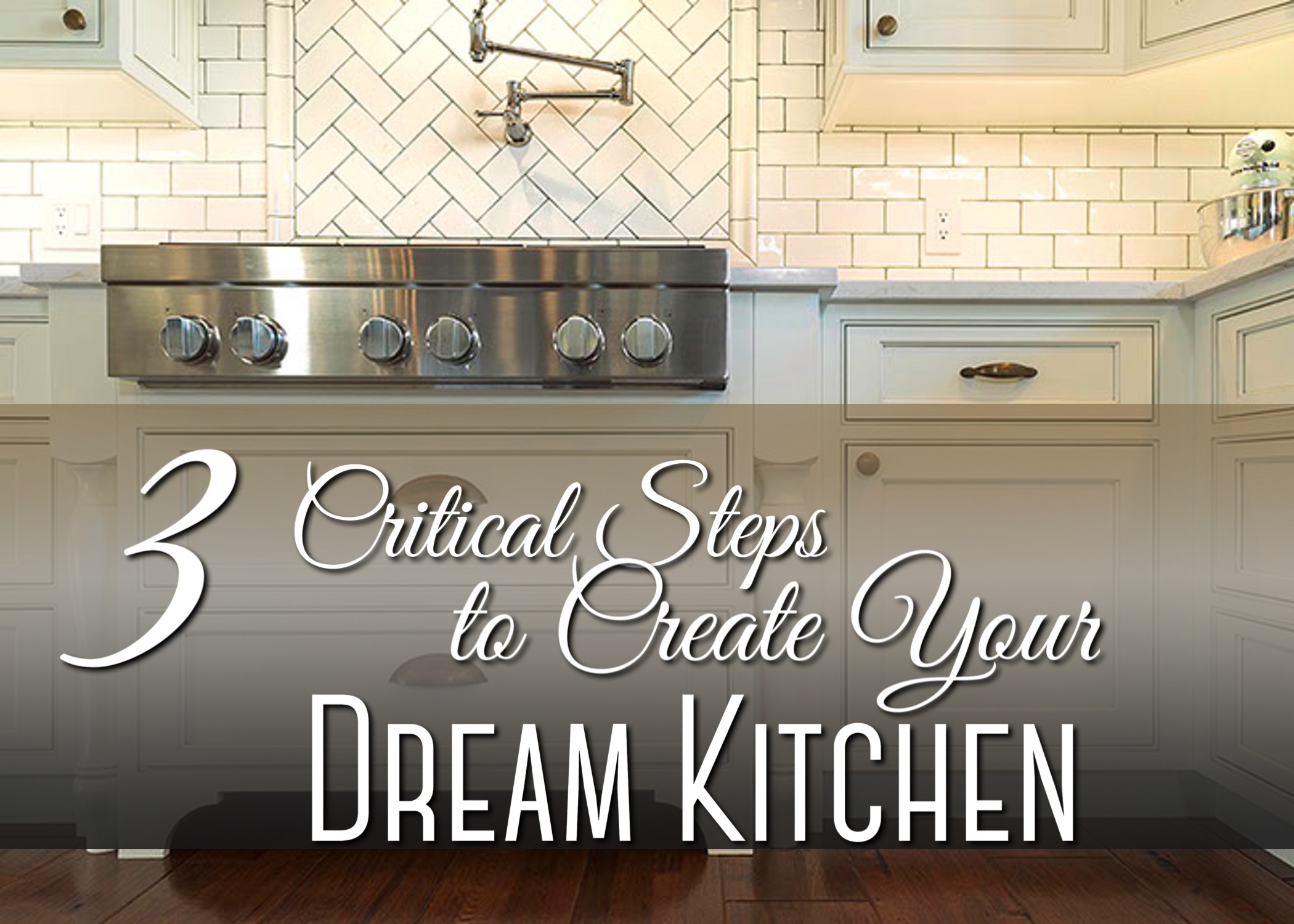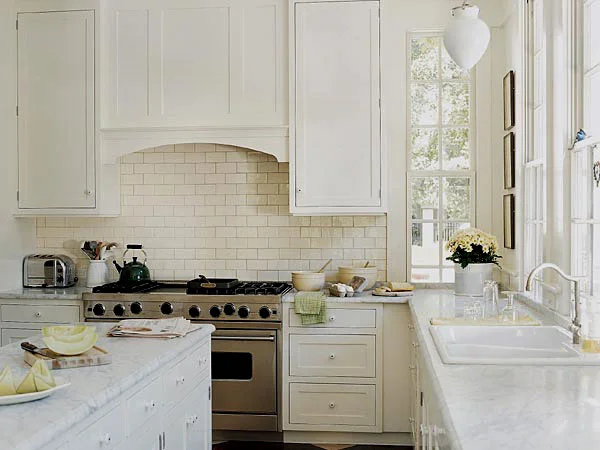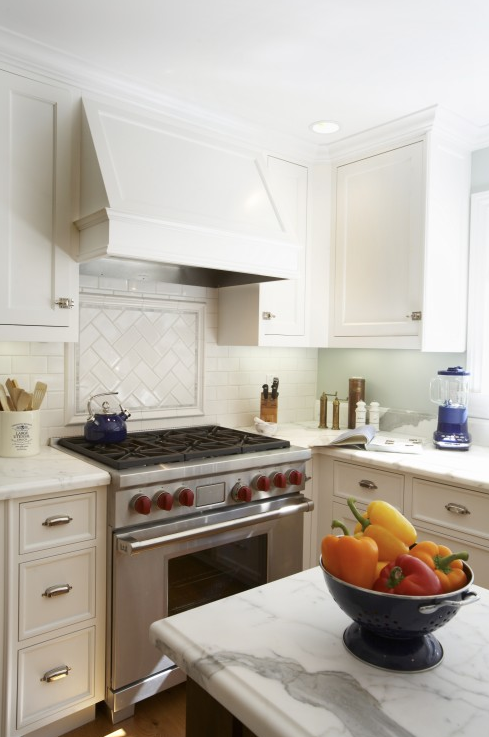Updating a kitchen is on my mind lately as my own is overdue for a makeover…I’ve had the privilege of helping many clients create their dream kitchens over the last 20 plus years. Researching new trends and gaining knowledge about the latest available options is one of my favorite pastimes. And my own kitchen saga taught me a few things early on as well.
A little history of my personal learning curve: When we bought our first house (back when dinosaurs roamed the earth), we settled on a split-level primarily because it was in “move-in” condition…it was the early 80’s and the house retained most of its original 1971 builder finishes. I didn’t love it. It had wall-to-wall avocado carpet upstairs and rust shag downstairs. The kitchen and bathrooms heavily featured harvest gold.
Imagine something like this only with a harvest gold fridge, even cheaper cabinets, and abundant ugly wallpaper....
We ripped out the particle board dark brown faux wood kitchen cabinets, scarred gold sheet vinyl flooring, and the layers of festive wallpaper. We replaced them with real wood cabinets in…honey oak - which the nice man at the lumberyard assured us was the way to go if we were staying more than 5 years (I know, I know, it was the prevailing trend and I was young and stupid, okay?). We installed ivory tile floors which started cracking and chipping almost immediately because it was cheap tile, and wallpaper in a ditzy Pennsylvania Dutch floral print featuring a daring navy background. Adding insult to injury I liberally sprinkled the room in a country motif. Ducks and hearts, specifically. Kitschy country decor was "in" at the time…(think of it as the tin letters/faux antique signs and chalkboard paint of the 80’s). Lucky for you, this predated the digital image age and I couldn’t put my hands on a picture to scan in, so you don’t have to bleach your eyeballs. You’re welcome.
In a fit of pique a few years later, I ripped out the cheap tile and put in hardwood floors to match the hardwood we had unearthed under all that avocado carpeting. I banished the ducks, stripped the wallpaper and added beadboard painted a favorite pale celery green. Less nightmare than where it started, but not exactly “dream kitchen” either.
I'm considerably older now, and MUCH wiser. SO What have I learned? For something as permanent and expensive as a kitchen, I recommend these 3 things:
Get Professional Advice
Get advice from a design professional (and I’m not talking about the nice man at the lumberyard, or even your neighbor who "has a good eye"). A professional can assess your goals, budget and needs and tell you the best way to meet those. They will have done this many, many times before and know all the latest things available and the pros and cons of each to help you spend wisely and get what you want. They will help you wade through the thousands of options and decisions you will need to make (this post talks more about those). Even if you DIY, consulting with a professional before you begin will be worth every penny. You do not want to finish up an expensive and time consuming renovation project and have regrets because you didn’t know what you didn’t know!
Choose Quality
Choosing quality is always a more economical decision. Quality will wear better and last longer and is especially important in a high use space like a kitchen. If you choose inferior products that need to be replaced more often, not only will you be inconvenienced by the repeat disruption, but you will generate disposal fees and installation or delivery fees each time you need to replace them.
Choose Classic
Classics are, by definition, always in style. If you choose classics, you don’t have to replace/live with a kitchen that looks dated 5 or 10 years after it was installed. I have seen a lot of trends come and go, but there are some ingredients that are timeless classics. So what are they?
Painted cabinets, most especially neutral painted cabinets.
I know magazine editors are bored to death with white and off white kitchens, so they are showing a variety of other exotic colors, but white and off-white kitchens have been around since the early 1900's and still account for over 80% of the cabinets sold and show no signs of going away. That said, there are some beautiful examples of kitchens with stained wood cabinets that are gorgeously classic and are perfect for the architecture - my parents installed beautiful dark chocolate cherry cabinetry with white counters and backsplash in their antique colonial over 40 years ago and it still looks timeless - but in terms of broadest appeal, neutral paint is still the winner. Style-wise, simple recessed panel doors are a ‘can’t miss’ choice that works well with a variety of informal architectural styles, or raised panel for a more formal look. Avoid anything with a lot of fussy detailing.
Classic backsplashes…wall tile is forever.
Choose neutral colors and classic patterns unless you can afford the time, mess, and money to change it in 5 years. You can never go wrong with white subway tile – it has been around for ages. Running bond or herringbone patterns are great, hip vertical patterns and trendy tile shapes, colors, and sizes will probably look dated fairly quickly. If a stone look is more your taste, then limestone or white marble are classics as well as their new porcelain and quartz counterparts (this post talks about some of the high performance lookalikes available).
Counters in a natural stone look.
Choose a light marble look, or a dark solid granite or soapstone look (or a mix if you have an island). It is tempting to fall in love with an exotic stone…there are many stunning ones. But, considering the amounts needed for a kitchen, it would be tragic if you tired of it after a few years. It is usually wisest to stick to neutrals with simple edge detailing and standard thicknesses for the most longevity.
Open shelving
This has been around pretty much since the advent of the idea of kitchens. It seems to come in and out of fashion and some people hate it because they are paranoid about dust, but I think it makes for a much friendlier and open feeling in a kitchen than 2 or 3 walls of unrelieved solid cabinet doors at eye level. If you can eliminate some upper cabinets and add windows instead, that would be even better. Natural light is always a winner! The compromise might be to mix in some glass-doored cabinets - these also have a long history dating back to the early 1900's. Every kitchen is different and every homeowner is different. Your storage needs, preferences, lifestyle, and house architecture and layout will all be determining factors in the configuration you choose.
With wise planning and choices, your kitchen will bring you joy every single day for years to come!
Need help creating your dream kitchen? Contact us to start the conversation!






